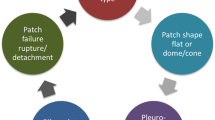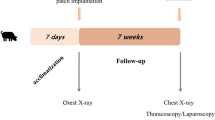Abstract
There is no ideal bio-tensile material for tissue replacement in paediatric surgical conditions. A variety of materials have been described to replace or reinforce tissue deficits in congenital diaphragmatic hernia (CDH). The problems with these materials range from extensive surgery to body wall deformity and hernia recurrence. The ideal graft would be safe, strong, have the potential to grow and not require replacement, not affect chest wall development or produce deformity, and have minimal risk of recurrence. Surgisis is a biomaterial composed of porcine intestinal submucosa that provides inherent tensile strength as a collagen lattice and is ultimately replaced by native collagen tissue. Our objective was to prospectively assess the utility of Surgisis as a replacement graft in a cohort of 10 children undergoing primary or recurrent CDH repair. The graft was well tolerated, and there was no recurrence of herniation. We conclude that Surgisis collagen mesh may be a useful alternative for tissue replacement or reinforcement in difficult cases of CDH and diaphragmatic agenesis. The biological framework of Surgisis may also prove useful in other situations of complex tissue loss in children.


Similar content being viewed by others
References
Puri P, Gorman WA (1987) Natural history of congenital diaphragmatic hernia: implications for management. Pediatr Surg Int 2:327–330
Clark RH, Hardin WD, Jr., Hirschl RB, et al. (1998) Current surgical management of congenital diaphragmatic hernia: a report from the Congenital Diaphragmatic Hernia Study Group. J Pediatr Surg 33:1004–1009
Moss RL, Chen CM, Harrison MR (2001) Prosthetic patch durability in congenital diaphragmatic hernia: a long-term follow-up study. J Pediatr Surg 36:152–154
Hajer GF, vd Staak FH, de Haan AF, Festen C (1998) Recurrent congenital diaphragmatic hernia: which factors are involved? Eur J Pediatr Surg 8:329–333
Badylak S, Kokini K, Tullius B, Whitson B (2001) Strength over time of a resorbable bioscaffold for body wall repair in a dog model. J Surg Res 99:282–287
Hodde JP, Record RD, Liang HA, Badylak SF (2001) Vascular endothelial growth factor in porcine-derived extracellular matrix. Endothelium 8:11–24
Dalla Vecchia L, Engum S, Kogon B, Jensen E, Davis M, Grosfeld J (1999) Evaluation of small intestine submucosa and acellular dermis as diaphragmatic prostheses. J Pediatr Surg 34:167–171
Specke V, Schuurman HJ, Plesker R, et al. (2002) Virus safety in xenotransplantation: first exploratory in vivo studies in small laboratory animals and non-human primates. Transpl Immunol 9:281–288
Moyer V, Moya F, Tibboel R, Losty P, Nagaya M, Lally KP (2002) Late versus early surgical correction for congenital diaphragmatic hernia in newborn infants. Cochrane Database Syst Rev 2002:CD001695
Allman AJ, McPherson TB, Badylak SF, et al. (2001) Xenogeneic extracellular matrix grafts elicit a TH2-restricted immune response. Transplantation 71:1631–1640
Calvano CJ, Moran ME, Parekh A, Desai PJ, Cisek LJ (2000) Laparoscopic augmentation cystoplasty using the novel biomaterial Surgisis: small-intestinal submucosa. J Endourol 14:213–217
Record RD, Hillegonds D, Simmons C, et al. (2001) In vivo degradation of 14C-labeled small intestinal submucosa (SIS) when used for urinary bladder repair. Biomaterials 22:2653–2659
Author information
Authors and Affiliations
Corresponding author
Rights and permissions
About this article
Cite this article
Smith, M.J., Paran, T.S., Quinn, F. et al. The SIS extracellular matrix scaffold—preliminary results of use in congenital diaphragmatic hernia (CDH) repair. Ped Surgery Int 20, 859–862 (2004). https://doi.org/10.1007/s00383-004-1298-0
Accepted:
Published:
Issue Date:
DOI: https://doi.org/10.1007/s00383-004-1298-0




